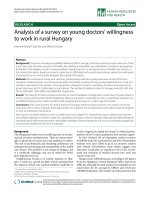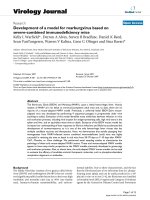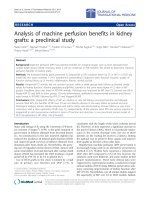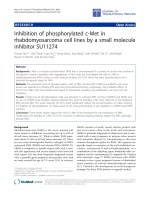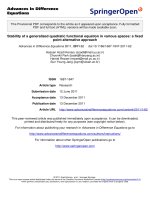Báo cáo sinh học: "Comparison of four statistical methods for detection of a major gene in a progeny test design" pptx
Bạn đang xem bản rút gọn của tài liệu. Xem và tải ngay bản đầy đủ của tài liệu tại đây (720.5 KB, 17 trang )
Original
article
Comparison
of
four
statistical
methods
for
detection
of
a
major
gene
in
a
progeny
test
design
P. Le Roy
J.M.
Elsen
1
S.
Knott
2
1
Institut
National
de
la
Recherche
Agronomique,
centre
de
recherches
de
Toulouse,
station
d’amélioration
génétique
des
animaux,
Auzeville
31.i26
Castanet-Tolosan
Cedex,
France
2
AFRC,
IAPGR,
Edinburgh
Research
Station,
Roslin,
Midlothian,
EH
25
9PS,
UK
(received
17
August
1988,
accepted
23
January
1989)
Summary -
In
livestock
improvement
it
is
common
to
design
a
progeny
test
of
sires
in
order
to
estimate
their
breeding
values.
The
data
recorded
for
these
estimate
are
useful
for
the
detection
of
major
genes.
They
are
the
n.m
performances
Yg!
of
m
progeny j
of n
sires
i.
These
data need
to
be
corrected
for
the
polygenic
influence
of
the
sire
on
its
progeny
(sire
i
effect
Ui
).
Four
statistical
tests
of
the
segregation
of
a
major
gene
are
compared.
The
first
(ISA
for
"segregation
analysis")
is
the
classical
ratio
of
the
likelihoods
under
Ho
(no
major
gene)
and
Hi
(a
major
gene
is
segregating).
The
parameters
describing
the
population
(means
and
standard
deviations
within
genotype)
are
estimated
by
maximizing
the
marginal
likelihood
of
the
Yij.
The
other
statistics
studied
are
approximations
of
this
I
SA
statistic
where
the
sire
i
effect
(U
Z)
is
considered
as
a
fixed
effect
(lFE
statistic)
or,
following
Elsen
et
al.
(1988)
and
H6schele
(1988),
where
the
parameters,
and
Ui,
are
estimated
maximizing
the
joint
likelihood
of
Ui
and
Yij
(lME
,
and
I
ME2
statistics).
Simulation
studies
were
done
in
order
to
describe
the
distribution of
these
statistics.
It
is
shown
that
I
SA
and
1
ME
,
are
the
most
powerful
test,
followed
by
I
ME2
,
whose
relative
loss
of
power
ranged
between
20
and
40%,
depending
on
the
Hi
case
studied,
when
400
progeny
are
measured
(n
=
m
=
20).
The
segregation
analysis,
based
on
direct
maximization
of
the
likelihood,
required
30
times
more
computation
time
than
the
1
ME
test
using
an
EM
algorithm.
major
gene -
segregation
analysis -
statistical
test
Résumé -
Comparaison
de
quatre
méthodes
statistiques
pour
la
détection
d’un
gène
majeur
dans
un
test
sur
descendance.
Il
est
fréquent,
en
sélection,
de
tester
sur
descendance,
des
mâles,
afin
d’estimer
leur
valeur
génétique.
Les
données
recueillies
dans
ce
but
peuvent
être
utilisées
afin
de
mettre
en
évidence
un
gène
majeur.
Elles
sont
constituées
des
n.m
performances
Y
ij
de
m
descendants j
de
n
mâles
i.
Ces
données
doivent
être
corrigées
pour
l’ef,!’et
polygénique
du
père
(U;)
sur
ses
descendants.
Quatre
tests
statistiques
de
mise
en
évidence
d’un
tel
gène
majeur
sont
comparés.
Le
premier
(l
Sp
pour
"segregation
analysis")
est
le
rapport
classique
des
vraisemblances
sous
Ho
(pas
de
gène
majeur)
et
sous
Hl
(existence
d’un
gène
majeur).
Les
paramètres
caractéristiques
de
la
population
(moyennes
et
écarts
types
intragénotype)
sont
estimés
en
maximisant
la
vraisemblance
marginale
des
Y
ij
.
Les
autres
statistiques
de
tests
sont
des
approximations
de
I
SA
pour
lesquelles,
soit
l’ef,!’et
père
Ui
est
considéré
comme
un
effet
fixé
(test
I
FE
)
soit,
comme
proposé
par
Elsen
et
al.
(1988)
et
Hôschele
(1988),
les
paramètres,
et
Ui,
sont
obtenus
en
maximisant
la
vraisemblance
conjointe
des
Y;j
et
des
Ui
(test
I
ME1
et
I
ME2
).
Nous
avons
réalisé
des
simulations
afin
de
décrire
les
distributions
de
ces
tests.
I
SA
et
I
ME1
sont
les
tests les
plus
puissants,
suivi
par
I
ME2
,
dont la
perte
relative
de
puissance
varie
entre
20
et
40%
selon
l’hypothèse
Hl
étudiées,
quand
400
descendants
sont
mesurés
(n
=
m
=20).
L’analyse
de
ségrégation,
réalisée
par
maximisation
directe
de
la
vraisemblance,
demande
30
fois
plus
de
temps
de
calcul
que
les
tests
1
ME
réalisés
l’aide
d’un
algorithme
EM.
gène
majeur -
analyse
de
ségrégation -
test
statistique
INTRODUCTION
In
recent
years,
several
genes
having
major
effects
on
commercial
traits
have
been
identified.
The
dwarf
gene
in
poultry
(Merat
&
Ricard,
1974),
the
halothane
sensitivity
gene
in
pigs
(Ollivier,
1980),
the
Booroola
gene
in
sheep
(Piper
&
Bindon,
1982),
or
the
double
muscling
gene
in
cattle
(M6nissier,
1982)
are
notable
examples.
These
discoveries,
as
well
as
improvement
of
transgenic
techniques,
have
stim-
ulated
interest in
new
techniques
for
detection
of
single
genes.
Various
tests
have
been
described
concerning
livestock
(Hanset,
1982).
Their
general
principle
is
that
the within
family
distribution
of
the
trait
depends
on
the
parents’
genotypes,
and
therefore
varies
from
one
family
to
another.
These
methods
involve
simple
computa-
tions
but
are
not
powerful.
Concurrently,
segregation
analysis
in
complex
pedigrees
was
developed
in
human
genetics
(Elston
&
Stewart,
1971)
by
comparing
the
like-
lihoods
of
the
data
under
different
trait
transmission
models.
These
methods
are
much
more
powerful
than
the
previous
ones,
but
involve
much
computation.
They
require
numerical
simplification
to
deal
with
the
population
structure
of
farm
an-
imals.
Additionally,
the
known
properties
of
the
test
statistics,
a
likelihood
ratio
test,
are
only
asymptotic,
which
raises
the
question
of
their
validity
when
applied
to
samples
of
limited
size.
’
In
livestock
improvement
it
is
common
to
use
progeny
tests
where
males
are
mated
to
large
numbers
of
females.
Concentrating
on
this
simple
family
structure
the
present
paper
tries
to
give
some
elements
of
a
solution
to
the
problems
of
simplification
and
validity.
Four
methods
are
compared
on
simulated
data.
METHODS
The
four
methods
considered
rely
upon
the
same
information
structure
and
the
same
type
of
test
statistics.
Experimental
design
The
data
are
simulated
according
to
a
hierarchical
and
balanced
family
structure:
one
sample
consists
of
n
sire
families
(i
=
1, n)
with
m
mates
per
sire
( j
=
1, m)
and
one
offspring
per
dam.
Sires
and
dams
are
assumed
to
be
unrelated.
Only
offspring
are
measured,
with
one
1’
;j
datum
per
animal.
Models
and
notations
Models
The
Ri j
performances
are
considered
under
the
two
following
models:
General
hypothesis
(H
i
):
&dquo;mixed
inheritance
&dquo;
In
this
model
a
monogenic
component
is
added
to
the
assumed
polygenic
variation.
When
two
alleles
A
and
a
are
segregating
at
a
major
locus,
three
genotypes
are
possible
(AA,
Aa,
aa)
which
we
shall
respectively
denote
1,
2,
3.
Sires
are
of
genotype
s(s
=
1, 2, 3)
with
probability
PS.
Dams
transmit
to
their
offspring
allele
A
with
a
probability
q and
allele
a
with
a
probability
1 —
q.
Conditional
on
its
genotype
t(t
=
l, 2, 3),
the
ijth
progeny
has
the
performance
Y.’.
The
following
linear
model
can
be
formulated.
ij
Where
lt
t
is
the
mean
value
of
the
performances
of
genotype
t
progeny.
Ui
is
the
sire
i random
effect,
assumed
to
be
independent
of
the
genotype
t
and
normally
distributed
with
a
mean
0
and
a
variance
U2 u
E
ij
is
the
residual
random
effect,
assumed
to
be
independent
of
the
genotype
t
and
normally
distribued
with
a
mean
0
and
a
variance
U2
e
Ui
and
E
ij
are
assumed
to
be
independent.
Concerning
production
traits
of
livestock,
the
proportion
of
variance
explained
by
polygenic
effects
has
been
generally
estimated
in
many
populations.
Thus,
we
shall
assume
known
a
priori
the
heritability
of
the
trait,
h2,
defined
as:
_.n
-
so
that
sires
are
assumed
to be
unselected.
The
model
thus
defined
on
seven
parameters:
This
hypothesis
(H
o
):
&dquo;podygenic
inheritance&dquo;.
Null
subhypothesis,
to
be
tested
against
the
general
model,
is
fixed
by
A
, =
U2 =
/-
t3
=
P0
&dquo;
Where
po
is
the
general
mean
of
the
performances.
Ui
and
E
ij
have
the
same
definition
as
under
Hi .
Matrix
notation
Let
S
be
the
vector
of
the
genotypes
of
the
n
males
S
=
(S
l,
,
Si,
,
Sn)
and
s
=
(s
i,
si,
sn)
one
realization
of
S.
Yi
be
the
vector
of
the
m
performances
of
the
ith
sire’s
progeny:
Yi =
(Y
l,
Ti!,
Yi
m
),
and
yi
the
vector
of
realizations
of Y
i.
Ti
the
vector
of
order
m
of
the
genotypes
at
the
major
locus
of
the
ith
sire’s
progeny:
Ti
=
(Ti
l,
Ti!,
Ti
m
).
Three
realizations
being
possible
for
T2!,
3m
different
realizations
ti
of
Ti
are
possible.
Prob
(T
i
=
t
il
si)
is
the
probability
of
the
realization
of
the
genotypes
vector
ti
=
(til
,
ti!,
t
im
)
when
sire
i
is
of
genotype
s;.
(I-
the
vector
of
genotype
means:
Given
E.t,
the
vector
of
order
m
of
residuals,
the
vector
Yi
can
be
written
under
Ho :
where
X
and
Z
are
two
matrices
of
order
m
x
1,
whose
elements
all
equal
1,
under
Hl:
where
Xi
ti
is
the
m
x
3
incidence
matrix
for
the
fixed
effects
of
the
model,
when
the
realization
of
the
genotypes
of
the
sire
i
progeny
is
ti.
The
Vi
covariance
matrix
for
the
performances
Y!
of
the
sire
i family
is:
with
D
=
0
&dquo;;
and
R
the
diagonal
m
x
m
matrix
R=
o-e 2.
1!.
General
expression
of
the
likelihood
ratio
test
(LR
test)
The
test
statistic
is
based
on
the
ratio
of
the
likelihoods
under
Ho
(M
o)
and
under
Hl (ll!I1 ),
or
an
estimate
of
this
ratio.
In
practice
the
test
statistic
considered
is:
1
=
-2.log
(Mo/
Mi
).
With
our
notation,
and
given
the
preceding
hypothesis,
Mo
is:
with
and
M¡
is:
The
four
proposed
methods
are
all
based
on
the
two
following
equalities:
and:
Where
v,
2
is
the
mode
of
the
distribution
of
Ui
given
Yi
and
the
genotypes
ti.
Formula
(2)
results
from
the
equality
of
mode
and
expectation
for
symetrical
distributions.
Definition
and
interests
of
the
four
proposed
methods
The
differences
between
the
four
methods
concern
the
sire
effects.
First
method:
SA
In
the
SA
method
(&dquo;segregation
analysis&dquo;,
Elston
1980),
we
consider
without
simplification
the
model
and
the
test
statistic
as
they
were
defined
above.
The
likelihoods
under
Hl
and
Ho
are
calculated
using
equality
(1)
and
taking
account
of:
Then:
with:
and;
with:
The
well
known
asymptotic
properties
of
the
LR
test
under
Ho
are
the
main
advantage
of
this
method.
If
some
regularity
conditions
hold,
the
test
statistic
I
is
asymptotically
distributed
according
to
a
central
x2
with
d
degrees
of
freedom,
d
being
the
number
of
parameters
with
fixed
value
under
Ho
(Wilks,
1938).
However,
in
the
particular
context
of
testing
a
number
of
components
in
a
mixture,
the
regularity
conditions
are
not
satisfied
since
the
mixing
proportions
pi
and
p2
have
the
value
zero
under
Ho,
which
defines
the
boundary
of
the
parameter
space.
Studying
mixtures
of
m-normal
distributions,
Wolfe
(1971)
suggested
that
the
distribution of
the
LR
test
is
proportional
to
a
X2
distribution
with
2d
degrees
of
freedom.
The
proportionality
coefficient
c
should
be
c
=
(n-1-m-1/2g
2
)/n
where
n
represents
the
sample
size,
and
92
the
number
of
components
in
the
mixture
under
Hl.
If
these
results
hold
in
our
case,
when
the
number
or
sires
is
very
large,
I
SA
should
have
a
x2
distribution
with
4
degrees
of
freedom.
The
problem
with
this
method
is
that
it
requires
heavy
computation:
a
complex
function
of
the
1!j
must
be
integrated
n
times
for
each
estimation
of
I
SA
-
Second
and
third
methods:
ME
These
methods
(&dquo;modal
estimation&dquo;
of
the
sire
effect
UZ
),
use
the
equation
(2).
Under
Ho,
the
likelihood
may
be
written
as
follows:
Under
Hl,
the
equality
(2)
leads
to
However,
the
sums
over
the
vectors
ti
for
each
sire
make
this
computation
practically
impossible
as
soon
as
m
is
larger
than
a
few
units
(3’
=
243,
3
10
=
59049).
Thus,
following
Elsen
et
al.
(1988)
we
suggest
the
approximation
Where
Ûi
is
the
distribution
mode
of
Ui
conditional
on
Yi,
whatever
the
genotypes
si
and
ti
are.
The
statistic
1
ME1
=
-2log(M
o
mEyN1
1
ME
1)
is
no
longer
an
LR
test
but
an
approximation
lacking
the
asymptotic
properties
described
above.
However
we
hope
that
this
statistic
which
requires
much
less
computation
will
nonetheless
retain
the
power
of
the
first
proposed.
An
alternative
to
this
second
method
is
to
estimate
the
likelihood
ll!losA
and
M1
SA
directly
by:
where
Ûi
is
defined
as
above.
As
stated
by
H6schele
(1988)
this
&dquo;approximation
will
be
close
to
I
SA
only
if
the
likelihood
is
very
peaked
(m -j
oo)
with
most
of
its
probability
mass
concentrated
over
a
small
region
about
the
ML
estimates&dquo;.
Fourth
method:
FE
The
method
(fixed
effect
of
the
sires),
does
not
consider
the
a
priori
information
contained
in
the
heritability
of
the
trait.
The
ui
sire
effects
are
assumed
to
be
fixed,
and
become
supplementary
parameters
which
need
to
be
estimated.
The
likelihood
ratio
may
be
written:
with:
and:
This
method
has
the
advantage
of
its
computational
simplicity,
while
retaining
the
well
known
asymptotic
properties
of
the
LR
test.
However,
there
may
be
an
important
loss
of
power,
due
to
the
loss
of
information
on
the
polygenic
variation.
The
comparisons
Three
problems
were
studied:
Distributions
of
the
statistics
under
Ho
We
have
just
mentioned
uncertainties
concerning
the
asymptotic
distributions
(X2
2
with
4
degrees
of freedom
for
I
SA
and
1
FE
if Wolfe’s
(1971)
approximation
is
valid,
no
known
property
for
l
ME).
Furthermore
these
distributions
are
unknown
in
samples
of
limited
size.
In
order
to
estimate
these
distributions,
samples
were
simulated
under
Ho
(500
samples
for
SA,
1000
for
FE
and
ME)
with
different
numbers
of
sires
(n
=
5, 10, 20)
and
of
progeny
per
sire
(m
=
5, 10, 20).
The
test
statistics
I
SA
,
!MEi,
I
ME2
and
I
FE
were
calculated
for
each
sample.
The
estimated
distributions
obtained
were
used
to
test
the
convergences
to
X2
distributions.
They
also
helped
determine
boundaries
for
critical
regions
in
samples
of
a
limited
size.
We
used
the
Harrel
and
Davis
(1982)
method
to
estimate
quantiles
at
5
and
1%
and
their
jackknife
variance
as
defined
by
Miller
(1974).
These
simulations
were
based
on
a
heritability
of
0.2.
Comparisons
of
the
powers
By
using
the
table
of
the
critical
regions
thus
obtained
for
each
family
structure,
we
have
been
able
to
compare
the
powers
of
the
tests.
These
powers
depend
not
only
on
the
number
and
size
of
the
families
in
the
sample
but
also
on
the
values
of
the
parameters
(p,
<
7
g,
pl,
p2,
q)
which
characterize
the
major
gene
segregating
in
the
population.
’
For
each
of
the
9
family
structures
described
above,
three
HI
hypotheses
were
considered,
each
with
a
simulation
of
100
samples.
All
these
populations
are
assumed
to
follow
the
Hardy
Weinberg
law.
The
differences
between
the
three
Hl
hypotheses
lie
in
the
mean
effects
of
the
genotypes
(expressed
in
standard
deviation
units)
and
the
frequency
of
the
allele
A.
Case
1:
complete
dominance
and
equal
allele
frequencies
Case
2:
additivity,
equal
allele
frequencies
Case
3:
Complete
dominance,
recessive
allele
rare
The
power
of
the
tests
was
measured
by
the
percentage
of
Ho
rejection.
Algorithms
and
cost
of
calculations
The
methods
must
also
be
compared
on
the
basis
of
how
much
computation
they
require.
The
calculations
described
above
were
made
using
the
quadrature
and
optimization
subroutines
of
the
NAG
fortran
library.
In
order
to
maximize
the
likelihoods
of
the
sample
we
used
a
Quasi-Newton
algorithm
in
which
the
derivatives
are
estimated
by
finite
differences.
The
same
algorithm
was
used
for
the
four
methods,
giving
results
of
a
similar
degree
of
precision.
However,
various
algorithms
can
be
used
to
estimate
the
maximum
likelihood
of
the
parameters.
In
the
ME
and
FE
tests,
the
first
derivatives
have
a
simple
algebraic
form
and
the
maximum
likelihood
solutions
are
reached
by
zeroing
the
first
derivatives
(with
respect
to
each
of
the
parameters)
of
the
logarithm
of
the
likelihood.
Under
Hl
the
corresponding
system
of
equations
can
be
solved
iteratively,
but
not
directly,
by
using
for
instance
the
EM
algorithm
defined
by
Dempster
et
al.
(1977):
see
appendix.
This
is
the
algorithm
we
used
for
the
ME2
test
in
order
to
obtain
more
extensive
information
on
critical
region:
5, 10, 20,
and
40
sires,
5, 10, 20
and
40
progenies/sire,
heritability
of
0,
0.2,
0.4.
RESULTS
AND
DISCUSSION
Comparison
of
the
four
methods
Tables
I
to
IV
show
the
main
characteristics
of
the
distributions
of
the
4
test
statistics:
mean,
standard
deviation,
5%
and
1%
empirical
quantiles
and
percentage
of
replicates
beyond
the
5%
and
1%
quantiles
of a x4.
Table
V
shows
their
powers.
First,
we
can
note
that
for
the
number
of
progeny
increases,
the
mean
distribu-
tions
as
the
four
test
statistics
decrease
(except
I
SA
between
m
=
5
and
m
=
10
for
n = 5).
The
fact
that
1
statistics
distributions
converge
toward
a
X2
with
4
degrees
of
freedom
cannot
be
confirmed
since
all
the
distributions
of
l,
but
one
(segregation
analysis
with
5
sires
and
5
progenies/sire),
are
significantly
different
from
a
k2
using
a X2
test
of
fit.
Moreover,
the
scaled
statistics
(2E(l)/var
(l)).
l
are
also
significantly
different
from
a
x2.
It
must
be
emphasized
that
the
samples
studied
are
far
from
the
conditions
of
validity
of
Wolfe’s
approximation
which
requires
that n
>
10.m
(Everitt,
1981).
The
I
SA
statistics
show
a
notable
stability
as
the
family
size
varies,
whereas
for
I
FE
the
statistics
only
reaches
an
asymptote
as
m,
the
number
of
progeny
per
sire
increases.
As
regards
the
I
ME
statistics,
the
results
are
totally
different.
The
mean
and
standard
deviation
of
the
I
ME1
statistic
decreases
when
the
number
of
sires
or
progeny
per
sire
increases.
It
appeared
that
the
distribution
of
this
I
MEI
statistic
becomes
very
peaked
near
zero.
It
must
be
noticed
that
this
pattern
is
close
to
the
asymptotic
distribution
of
the
LR
test
of
a
mixture
of
2
known
distributions
in
unknown
proportion
studied
by
Titterington
et
al.
(1985).
These
authors
found
that,
under
Ho
(only
one
component)
the
LR
test
&dquo;is
0
with
a
probability
0.5
and,
with
the
same
probability,
is
distributed
as
a
x2
with
one
degree
of
freedom&dquo;.
On
the
other
hand,
for
a
given
number
of
progeny,
the
mean
of
the
l
ME2
distribution
increases
with
the
number
of
sires.
The
fewer
the
progeny,
the
greater
the
increase.
The
calculation
of
the
power
(Table
V)
shows
some
important
facts:
very
low
power
of
the
four
statistics
for
low
number
of
sires
and/or
progeny,
clear
superiority
of
the
segregation
analysis
and
first
of
the
modal
estimation
method
whatever
numbers,
with
respectively
a
90%
and
a
80%
power
in
the
best
case
(though
involving
only
400
animals),
very
poor
performance
of
the
I
FE
statistic,
intermediate
power
for
l
ME2
.
Thus
knowledge
of
heritability
is
a
substantial
advantage
and
gives
a
reason
to
prefer
the
I
ME
statistics
against
the
1
FE
,
which
requires
similar
amounts
of
computation.
The
comparison
of
powers
in
hypothesis
Hl
is
also
interesting:
it
is
much
more
difficult
to
detect
an
additive
major
gene
(case
2)
than
a
dominant
one
(case
1)
even
with
the
segregation
analysis
which
is
3
to
4
times
less
powerful
in
case
2
than
in
case
1.
In
comparison
with
the
isofrequent
case,
the
third
case
shows
a
50%
loss
of
power:
with
measurements
made
on
a
small
population,
very
few
individuals
if
any,
belong
to
the
high
mean
distribution.
The
computation
requirements
have
been
estimated,
on
a
3083
IBM
computer,
by
the
CPU
time
needed
for
the
evaluation
of
the
statistics
under
Ho.
Ten
replicates
of
a
sample
of
10
sires
and
10
progenies
per
sire
used
640
s
for
the
ls
A
statistic,
142
s
for
the
I
FE
statistic
and
48
s
for
the
I
ME
statistics.
Using
the
EM
algorithm
instead
of
the
direct
maximization
of
INt
E
with
the
NAG
subroutines
decreases
the
time
requirements
to
20
s
only.
Thus,
the
proposed
simplified
tests
l
ME
are
30
times
as
fast
as
the
segregation
analysis.
Tables
of
quantiles
Although
theoretical
works
are
still
needed
in
order
to
describe
the
asymptotic
behaviour
of
the
I
SA
,
I
ME
,
and
1
FE
tests,
one
can
use,
as
a
first
approach,
the
quantiles
given
in
our
tables
for
larger
populations
since
this
will
produce
an
overestimation
of
the
first
type
error.
On
the
contrary,
some more
calculations
are
needed
for
the
l
ME2
test.
The
5
and
1%
points
for
this
statistic
are
given
in
figures
1
to
3
depending
on
the
heritability
(0.0,
0.2,
0.4).
Each
figure
gives
these
points
for
varying
numbers
of
sires
and
progeny
per
sire.
Note
that
when
the
heritability
is
0.,
the
sire
effect
is
not
defined
and,
thus,
that
the
ui
(a
+
1]
terms
disappear
from
the
equations
given
in
the
appendix.
The
results
of
Table
III
are
confirmed:
the
quantile
estimates
increase
with
the
number
of
sires
n
(for
a
given
number
of
progeny
per
sire,
m)
and
decrease
when
the
number
of
progeny
per
sire
increases.
Two
other
results
must
be
noticed:
- given
n and
m,
the
lower
the
heritability,
the
greater
the
quantiles.
-
on
the
variation
range
studied
for
m,
the
number
of
progeny
per
sire,
the
increase
of
the
quantiles
is
nearly
linear
with
n
(number
of
sires)
allowing
some
extrapolations
for
higher
values of
this
number.
the
jackknife
standard
deviation
of
the
estimated
quantile
varies,
for
the
5%
case,
between
0.23
and
0.89,
with
a
mean
value
of
0.52
and,
for
the
1%
case,
between
0.39
and
1.65
with
a
mean
value
of
0.92.
These
errors
could
explain
the
observed
deviations
of
the
plotted
curves
from
smoothness.
CONCLUSIONS
On
the
four
statistical
tests
studied,
the
&dquo;segregation
analysis&dquo;
method
is,
as
expected,
the
most
powerful.
Applied
on
a
large
scale,
this
test
requires
a
great
deal
for
computation.
The
&dquo;modal
effect&dquo;
method
requires
much
less
computation
than
the
segregation
analysis
and
shows
practically
no
loss
of
power
for
the
first
version
and
a
limited
loss
of
power
(diminishing
as
soon
as
the
sample
size
is
sufficient)
for
the
second
version.
Unfortunately,
the
asymptotic
distribution
of
this
last
statistic
is
unknown.
The
tables
of
quantiles
we
obtained
by
simulation
permit
the
utilization
of
this
test
for
typical
sample
sizes
and
for
various
heritability
values.
REFERENCES
Dempster
A.P.,
Laird
N.M.
&
Rubin
D.B.
(1977)
Maximum
likelihood
from
incomplete
data
via
the
EM
algorithm.
J.
R.
Statist. Soc.,
Series
B
39,
1-38
Elsen
J.M.,
Vu
Tien
Khang
J.
&
Le
Roy
P.
(1988)
A
statistical
model
for
genotype
determination
at
a
major
locus
in
a
progeny
test
design.
Genet.
Sel. Evol.
20,
211-226
.
Elston
R.C.
(1980)
Segregation
analysis.
In:
Current
developments
in
anthropologi-
cal
genetics
(Mielke
J.H.
&
Crawford
M.H.
eds),
1,
Plenum
Publishing
Corporation,
New
York,
327-354
Elston
R.C.
&
Stewart
J.
(1971)
A
general
model
for
the
genetic
analysis
of
pedigree
data.
Hum.
Hered.
21,
523-542
Everitt
B.S.
(1981)
A
Nlonte
Carlo
investigation
of
the
likelihood
ratio
test
for
the
number
of
components
in
a
mixture
of
normal
distributions.
Multivar.
Behav.
Res.
16,
171-180
Hanset
R.
(1982)
Major
genes
in
animal
production,
examples
and
perspectives:
cattle
and
pigs.
2nd
world
congress
on
genetics
applied
to
livestock
production,
Madrid,
,!-8
oct.,
1982,
5,
Editorial
Garsi,
Madrid,
439-453
Harrel
F.E.
&
Davis
C.E.
(1982)
A
new
distribution-free
quantile
estimator.
Biometrika
69,
635-640
H6schele
1.
(1988)
Statistical
techniques
for
detection
of
major
genes
in
animal
breeding
data.
Theor.
Appl.
Genet.
76,
311-319
M6nissier
F.
(1982)
Present
state
of
knowledge
about
the
genetic
determination
of
muscular
hypertrophy
or
the
double-muscled
trait
in
cattle.
In:
Muscle
hypertrophy
of
genetic
origin
and
its
use
to
improve
beef
production
(King
J.W.B.
&
M6nissier
F.
eds),
Martinus
Nijhof,
The
Hague,
387-428
M6rat
P.
&
Ricard
F.H.
(1974)
Etude
d’un
gene
de
nanisme
lie
au
sexe
chez
la
poule:
importance
de
1’6tat
d’engraissement
et
gain
de
poids
chez
1’adulte.
Ann.
Genet. Sel. Anim.
6,
211-217
Miller
R.G.
(1974)
The
Jackknife. A
review,
Biometrika
61,
1-15
Ollivier
L.
(1980)
Le
d6terminisme
g6n6tique
de
1’hypertrophie
musculaire
chez
le
porc.
Ann.
G6n6t.
Sel.
Anim.
12,
383-394
Piper
L.R.
&
Bindon
B.M.
(1982)
The
Booroola
Merino
and
the
performance
of
medium
non-pe!pin
crosses
at
Armidale.
In:
The
Booroola
Marino,
(Piper
L.R.,
Bindon
B.M.
&
Nethery
R.D.
eds),
CSIRO,
Melbourne,
9-20
Titterington
D.M.,
Smith
A.F.M.
&
Makow
U.E.
(1985)
Statistical
analysis
of
finite
mixture
distributions.
Wiley,
New
York
Wilks
S.S.
(1938)
The
large
sample
distribution
of
the
likelihood
ratio
for
testing
composite
hypotheses.
Ann.
Math.
Stat.
9,
60-62
Wolfe
J.H.
(1971)
A
Monte
Carlo
study
of
the
sampling
distribution
of
the
likelihood
ratio
for
mixture
of
multinormal
distributions.
Tech. Bull.,
STB
72-2,
Naval
Personnel
and
Training
Research
Laboratory,
San
Diego
APPENDIX
Application
of
the
EM
algorithm
to
the
estimation
of
the
test
statistic
hŒ
under
Hl
The
EM
algorithm
is
an
iterative
procedure.
Each
of
its
iterations
consists
of
two
steps
E
(Expectation)
and
M
(Maximization).
In
our
calculations
we
have
considered
that
convergence
is
obtained
when,
a
being
the
iteration
number,
the
following
inequality
is
satisfied:
Step
E
of
the
ath
iteration
consists
of
estimating
posterior
probabilities
of
the
observations
These
probabilities
are
estimated
using
the
ath
iteration
values
of
(
7e
[a],
q(a),
ui [a]
(i
=
l, , n),
pt
(a)
(t
=
1, 2, 3)
and
p! (a)
(s
=
1, 2, 3).
The
following
quantities
are
calculated
successively:
I
NIE1
[a +
1]
is
calculated
as
in
(3)
and
(4),
and
I
NIEZ
[a +
1]
is
calculated
as
in
(5)
and
(6).
Step
M
of
the
ath
iteration
Given
the
previous
posterior
probabilities,
the
distribution
parameters
are
obtained
by
annulling
the
derivatives
of l
ME[
a+1]
with
respect
to
these
parameters.
We
then
get:
the
denominator
being
n(m
+
1)
for
the
lKi
E2
test.




